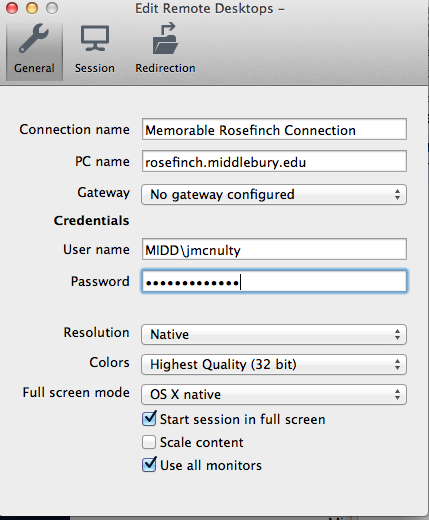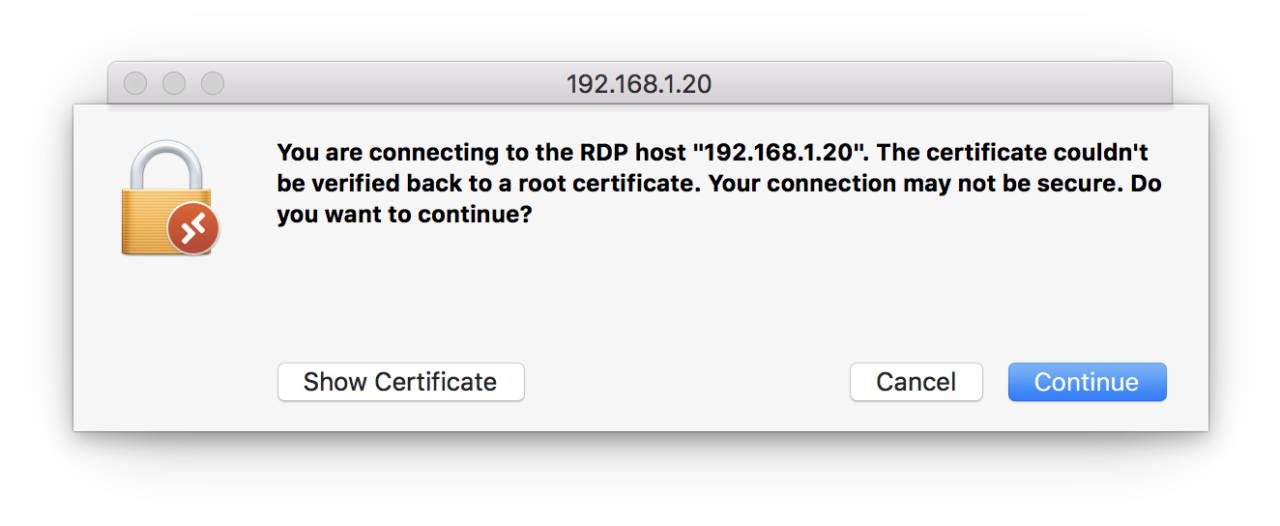Microsoft Remote Desktop, a free application from Microsoft, allows you to use a Mac laptop or desktop to connect to and work from a Windows desktop computer that you have RDP access to in your on-campus office or lab. If you aren't sure whether you have RDP access to a certain machine, feel free to check with ECN via our Trouble Report System:
Microsoft RDP for Mac is now called Microsoft Remote Desktop Connection Client for Mac (confusingly also known as RDC for Mac or Remote Desktop for Mac) and is probably the most well known way of remote networking on Windows. Remote Desktop Connection Client for Mac is a Microsoft tool which allows you to connect your Mac to PC Windows machines. RDP from Windows 10 to MAC I can RDP from my MAC to my Windows 10, but I want to go the other way. RDP is set up correctly because I use it to RDP to a variety of machines.
Put simply, Microsoft Remote Desktop from a laptop or a home computer makes it as if you're sitting at the desk in your office using your computer's keyboard and mouse -- even if you're two buildings, two miles, or two continents away.
By remotely accessing an ECN-supported desktop computer and refraining from storing your Purdue files locally on your laptop or home computer, your data remains safely stored in your home directory on ECN's network servers -- which receive daily backups.

If you have a Windows-based laptop or home computer, Microsoft provides Microsoft Remote Desktop for Windows 7, please see Remote Desktop Connection in Windows 7.The instruction on the page you're reading now focus on the MacOS version.
You'll want to follow these instructions on your Mac laptop and/or at-home Mac-- not on the on-campus desktop computer! Before you begin, download and install Microsoft Remote Desktop free via the App Store to your Mac.(Please note you'll need to be running 10.12.6 MacOS Sierra minimally, to run/download this application from the App Store).
When connecting from off-campus, please make sure to Purdue's VPN (www.webvpn.purdue.edu) first, as seen in step 1.
Who can use Microsoft Remote Desktop?
A remote-controlled computer can be used by only one person at a time. As such, this service is intended for use only by those who do not share the same office computer with other people. A graduate student may use Microsoft Remote Desktop with the permission of their supervisor.
Every ECN-supported Windows PC which will be used remotely must be pre-configured by ECN before this service will work. Please contact us in advance; we will provide you with the value that you'll need in step #3 as well.
Connecting to the Desktop Computer in Your Office
1. Connect to Purdue's Virtual Private Network. When using a computer off-campus, this step is required. Establish a connection to Purdue's Virtual Private Network (https://webvpn.purdue.edu). For a description of this service, please see ITaP's VPN 'Getting Started' page.
2. Launch the Microsoft Remote Desktop application from your Applications folder. The appropriate icon can be seen below:
3. Once the application opens up, you'll need to add your specific machine to the 'My Desktops' list. To do so, click on New. A new dialog will appear. Fill it out as seen below-- making sure to substitute '128.46.xxx.yyy' with the actual IP address of your machine, 'username' for your Purdue Career Account user name, and 'Password' for your account password. Please note though that you will need to type either 'boilerad' or 'ecn'before your user name in order to successfully authenticate to your machine.
NOTE: If using the ECN RemoteAvailability website, please instead use the computer hostname INSTEAD of the IP. you can do this by appending .boilerad.purdue.edu to the selected PC name from a green box.
IMPORTANT
If your computername begins with x- you will use 'boilerad' prior to your username.
If your computername DOES NOT begin with x- you will use 'ecn' prior to your username. Total war: warhammer - the grim and the grave.
Again, if you do not know your computer's IP, feel free to check with ECN via our Trouble Report System. Once you enter all of the necessary information, click the red circle in the top right corner of the dialog to close it out and save your configuration. You should now see 'Office PC' in your list under 'My Desktops.' Feel free to change the 'Connection name' of your configuration to anything you like. More specific names can be helpful when you need to set up connections to multiple machines on campus.
4. When you double click on your newly created RDP connection ('Office PC'), the following 'Verify Certificate' prompt may appear.
If it does, simply choose 'Continue.' Your Windows screen should then appear to you.
5. When you're ready to disconnect from your Windows machine, you may end the session in one of these ways:

- Click on the Start menu and select 'Disconnect.' This will end the remote session but leave files and programs open and running on your office PC.
- Click on the round red button at the top-left corner of the window. This will end the remote session but leave files and programs open and running on your office PC. If you do not see the Microsoft Remote Desktop application menu bar with the red button, simply hover your mouse at the top of your screen until it appears.
- Click on the Start menu and select 'Log off.' This will close all open files and programs on your office PC and also end the remote session.
Ms Rdp Client For Mac
Last modified: 2020/11/24 07:34:55.304958 US/Eastern by steven.e.schmidt.1
Created: 2008/07/31 10:21:59.307000 GMT-4 by john.a.omalley.1.

Ms Remote Desktop Mac M1
Categories
- Knowledge Base > ECN > RDP
- Knowledge Base > Software > RemoteDesktop
- Knowledge Base > OS > Mac
- Knowledge Base > OS > Mac > OS X
Search
Type in a few keywords describing what information you are looking for in the text box below.
Microsoft this week updated its Remote Desktop client for macOS, which allows users to access their computer through another device remotely. The latest update brought native support for the M1 chip, as well as some new features.
With native support for the Apple Silicon platform and the M1 chip, the app runs with better performance and more energy efficiency, which means that it should consume less battery power when running on a MacBook.
In addition, version 10.6 of Microsoft Remote Desktop for macOS also adds support for client-side IME when using Unicode keyboard mode, integrated Kerberos support in the CredSSP, and improved compatibility with macOS Big Sur. You can check out all the changes in the release notes below:
In this release we’ve made some significant updates to the shared underlying code that powers the Remote Desktop experience across all our clients. We’ve also added some new features and addressed bugs and crashes that were showing up in error reporting.
• Added native support for Apple Silicon.
• Added client-side IME support when using Unicode keyboard mode.
• Integrated Kerberos support in the CredSSP security protocol sequence.
• Addressed macOS 11 compatibility issues.
• Made updates to improve interoperability with current and upcoming features in the Windows Virtual Desktop service.
• Made fixes to address mispaints when decoding AVC data generated by a server-side hardware encoder.
• Addressed an issue where windows from remoted Office apps were not visible despite being present in the app switcher.
Users can download Microsoft Remote Desktop for free on the Mac App Store. There’s also an iOS version available that works with iPhone and iPad.
Read also:
FTC: We use income earning auto affiliate links.More.
